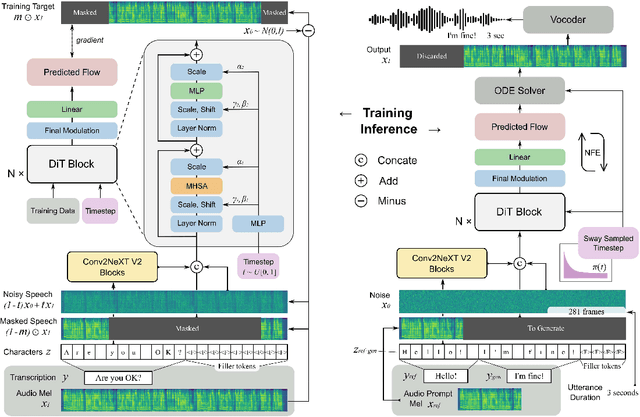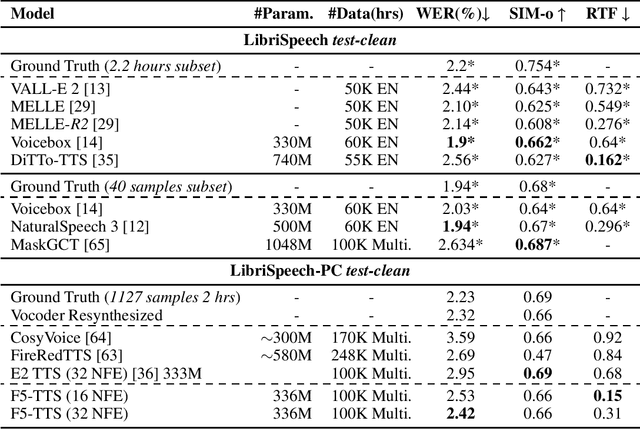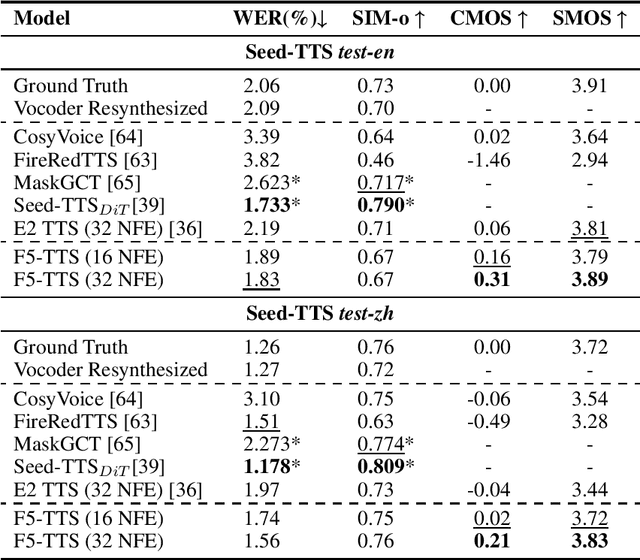Keqi Deng
SimulS2S-LLM: Unlocking Simultaneous Inference of Speech LLMs for Speech-to-Speech Translation
Apr 22, 2025



Abstract:Simultaneous speech translation (SST) outputs translations in parallel with streaming speech input, balancing translation quality and latency. While large language models (LLMs) have been extended to handle the speech modality, streaming remains challenging as speech is prepended as a prompt for the entire generation process. To unlock LLM streaming capability, this paper proposes SimulS2S-LLM, which trains speech LLMs offline and employs a test-time policy to guide simultaneous inference. SimulS2S-LLM alleviates the mismatch between training and inference by extracting boundary-aware speech prompts that allows it to be better matched with text input data. SimulS2S-LLM achieves simultaneous speech-to-speech translation (Simul-S2ST) by predicting discrete output speech tokens and then synthesising output speech using a pre-trained vocoder. An incremental beam search is designed to expand the search space of speech token prediction without increasing latency. Experiments on the CVSS speech data show that SimulS2S-LLM offers a better translation quality-latency trade-off than existing methods that use the same training data, such as improving ASR-BLEU scores by 3 points at similar latency.
Transducer-Llama: Integrating LLMs into Streamable Transducer-based Speech Recognition
Dec 21, 2024Abstract:While large language models (LLMs) have been applied to automatic speech recognition (ASR), the task of making the model streamable remains a challenge. This paper proposes a novel model architecture, Transducer-Llama, that integrates LLMs into a Factorized Transducer (FT) model, naturally enabling streaming capabilities. Furthermore, given that the large vocabulary of LLMs can cause data sparsity issue and increased training costs for spoken language systems, this paper introduces an efficient vocabulary adaptation technique to align LLMs with speech system vocabularies. The results show that directly optimizing the FT model with a strong pre-trained LLM-based predictor using the RNN-T loss yields some but limited improvements over a smaller pre-trained LM predictor. Therefore, this paper proposes a weak-to-strong LM swap strategy, using a weak LM predictor during RNN-T loss training and then replacing it with a strong LLM. After LM replacement, the minimum word error rate (MWER) loss is employed to finetune the integration of the LLM predictor with the Transducer-Llama model. Experiments on the LibriSpeech and large-scale multi-lingual LibriSpeech corpora show that the proposed streaming Transducer-Llama approach gave a 17% relative WER reduction (WERR) over a strong FT baseline and a 32% WERR over an RNN-T baseline.
F5-TTS: A Fairytaler that Fakes Fluent and Faithful Speech with Flow Matching
Oct 09, 2024



Abstract:This paper introduces F5-TTS, a fully non-autoregressive text-to-speech system based on flow matching with Diffusion Transformer (DiT). Without requiring complex designs such as duration model, text encoder, and phoneme alignment, the text input is simply padded with filler tokens to the same length as input speech, and then the denoising is performed for speech generation, which was originally proved feasible by E2 TTS. However, the original design of E2 TTS makes it hard to follow due to its slow convergence and low robustness. To address these issues, we first model the input with ConvNeXt to refine the text representation, making it easy to align with the speech. We further propose an inference-time Sway Sampling strategy, which significantly improves our model's performance and efficiency. This sampling strategy for flow step can be easily applied to existing flow matching based models without retraining. Our design allows faster training and achieves an inference RTF of 0.15, which is greatly improved compared to state-of-the-art diffusion-based TTS models. Trained on a public 100K hours multilingual dataset, our Fairytaler Fakes Fluent and Faithful speech with Flow matching (F5-TTS) exhibits highly natural and expressive zero-shot ability, seamless code-switching capability, and speed control efficiency. Demo samples can be found at https://SWivid.github.io/F5-TTS. We release all code and checkpoints to promote community development.
CoT-ST: Enhancing LLM-based Speech Translation with Multimodal Chain-of-Thought
Sep 29, 2024



Abstract:Speech Language Models (SLMs) have demonstrated impressive performance on speech translation tasks. However, existing research primarily focuses on direct instruction fine-tuning and often overlooks the inherent reasoning capabilities of SLMs. In this paper, we introduce a three-stage training framework designed to activate the chain-of-thought (CoT) capabilities of SLMs. We propose CoT-ST, a speech translation model that utilizes multimodal CoT to decompose speech translation into sequential steps of speech recognition and translation. We validated the effectiveness of our method on two datasets: the CoVoST-2 dataset and MuST-C dataset. The experimental results demonstrate that CoT-ST outperforms previous state-of-the-art methods, achieving higher BLEU scores (CoVoST-2 en-ja: 30.5->30.8, en-zh: 45.2->47.7, MuST-C en-zh: 19.6->21.2). This work is open sourced at https://github.com/X-LANCE/SLAM-LLM/tree/main/examples/st_covost2 .
Label-Synchronous Neural Transducer for E2E Simultaneous Speech Translation
Jun 06, 2024



Abstract:While the neural transducer is popular for online speech recognition, simultaneous speech translation (SST) requires both streaming and re-ordering capabilities. This paper presents the LS-Transducer-SST, a label-synchronous neural transducer for SST, which naturally possesses these two properties. The LS-Transducer-SST dynamically decides when to emit translation tokens based on an Auto-regressive Integrate-and-Fire (AIF) mechanism. A latency-controllable AIF is also proposed, which can control the quality-latency trade-off either only during decoding, or it can be used in both decoding and training. The LS-Transducer-SST can naturally utilise monolingual text-only data via its prediction network which helps alleviate the key issue of data sparsity for E2E SST. During decoding, a chunk-based incremental joint decoding technique is designed to refine and expand the search space. Experiments on the Fisher-CallHome Spanish (Es-En) and MuST-C En-De data show that the LS-Transducer-SST gives a better quality-latency trade-off than existing popular methods. For example, the LS-Transducer-SST gives a 3.1/2.9 point BLEU increase (Es-En/En-De) relative to CAAT at a similar latency and a 1.4 s reduction in average lagging latency with similar BLEU scores relative to Wait-k.
Wav2Prompt: End-to-End Speech Prompt Generation and Tuning For LLM in Zero and Few-shot Learning
Jun 01, 2024Abstract:Wav2Prompt is proposed which allows straightforward integration between spoken input and a text-based large language model (LLM). Wav2Prompt uses a simple training process with only the same data used to train an automatic speech recognition (ASR) model. After training, Wav2Prompt learns continuous representations from speech and uses them as LLM prompts. To avoid task over-fitting issues found in prior work and preserve the emergent abilities of LLMs, Wav2Prompt takes LLM token embeddings as the training targets and utilises a continuous integrate-and-fire mechanism for explicit speech-text alignment. Therefore, a Wav2Prompt-LLM combination can be applied to zero-shot spoken language tasks such as speech translation (ST), speech understanding (SLU), speech question answering (SQA) and spoken-query-based QA (SQQA). It is shown that for these zero-shot tasks, Wav2Prompt performs similarly to an ASR-LLM cascade and better than recent prior work. If relatively small amounts of task-specific paired data are available in few-shot scenarios, the Wav2Prompt-LLM combination can be end-to-end (E2E) fine-tuned. The Wav2Prompt-LLM combination then yields greatly improved results relative to an ASR-LLM cascade for the above tasks. For instance, for English-French ST with the BLOOMZ-7B1 LLM, a Wav2Prompt-LLM combination gave a 8.5 BLEU point increase over an ASR-LLM cascade.
FastInject: Injecting Unpaired Text Data into CTC-based ASR training
Dec 14, 2023Abstract:Recently, connectionist temporal classification (CTC)-based end-to-end (E2E) automatic speech recognition (ASR) models have achieved impressive results, especially with the development of self-supervised learning. However, E2E ASR models trained on paired speech-text data often suffer from domain shifts from training to testing. To alleviate this issue, this paper proposes a flat-start joint training method, named FastInject, which efficiently injects multi-domain unpaired text data into CTC-based ASR training. To maintain training efficiency, text units are pre-upsampled, and their representations are fed into the CTC model along with speech features. To bridge the modality gap between speech and text, an attention-based modality matching mechanism (AM3) is proposed, which retains the E2E flat-start training. Experiments show that the proposed FastInject gave a 22\% relative WER reduction (WERR) for intra-domain Librispeech-100h data and 20\% relative WERR on out-of-domain test sets.
Label-Synchronous Neural Transducer for Adaptable Online E2E Speech Recognition
Nov 19, 2023Abstract:Although end-to-end (E2E) automatic speech recognition (ASR) has shown state-of-the-art recognition accuracy, it tends to be implicitly biased towards the training data distribution which can degrade generalisation. This paper proposes a label-synchronous neural transducer (LS-Transducer), which provides a natural approach to domain adaptation based on text-only data. The LS-Transducer extracts a label-level encoder representation before combining it with the prediction network output. Since blank tokens are no longer needed, the prediction network performs as a standard language model, which can be easily adapted using text-only data. An Auto-regressive Integrate-and-Fire (AIF) mechanism is proposed to generate the label-level encoder representation while retaining low latency operation that can be used for streaming. In addition, a streaming joint decoding method is designed to improve ASR accuracy while retaining synchronisation with AIF. Experiments show that compared to standard neural transducers, the proposed LS-Transducer gave a 12.9% relative WER reduction (WERR) for intra-domain LibriSpeech data, as well as 21.4% and 24.6% relative WERRs on cross-domain TED-LIUM 2 and AESRC2020 data with an adapted prediction network.
Decoupled Structure for Improved Adaptability of End-to-End Models
Aug 25, 2023Abstract:Although end-to-end (E2E) trainable automatic speech recognition (ASR) has shown great success by jointly learning acoustic and linguistic information, it still suffers from the effect of domain shifts, thus limiting potential applications. The E2E ASR model implicitly learns an internal language model (LM) which characterises the training distribution of the source domain, and the E2E trainable nature makes the internal LM difficult to adapt to the target domain with text-only data To solve this problem, this paper proposes decoupled structures for attention-based encoder-decoder (Decoupled-AED) and neural transducer (Decoupled-Transducer) models, which can achieve flexible domain adaptation in both offline and online scenarios while maintaining robust intra-domain performance. To this end, the acoustic and linguistic parts of the E2E model decoder (or prediction network) are decoupled, making the linguistic component (i.e. internal LM) replaceable. When encountering a domain shift, the internal LM can be directly replaced during inference by a target-domain LM, without re-training or using domain-specific paired speech-text data. Experiments for E2E ASR models trained on the LibriSpeech-100h corpus showed that the proposed decoupled structure gave 15.1% and 17.2% relative word error rate reductions on the TED-LIUM 2 and AESRC2020 corpora while still maintaining performance on intra-domain data.
Label-Synchronous Neural Transducer for End-to-End ASR
Jul 06, 2023Abstract:Neural transducers provide a natural approach to streaming ASR. However, they augment output sequences with blank tokens which leads to challenges for domain adaptation using text data. This paper proposes a label-synchronous neural transducer (LS-Transducer), which extracts a label-level encoder representation before combining it with the prediction network output. Hence blank tokens are no longer needed and the prediction network can be easily adapted using text data. An Auto-regressive Integrate-and-Fire (AIF) mechanism is proposed to generate the label-level encoder representation while retaining the streaming property. In addition, a streaming joint decoding method is designed to improve ASR accuracy. Experiments show that compared to standard neural transducers, the proposed LS-Transducer gave a 10% relative WER reduction (WERR) for intra-domain Librispeech-100h data, as well as 17% and 19% relative WERRs on cross-domain TED-LIUM 2 and AESRC2020 data with an adapted prediction network.
 Add to Chrome
Add to Chrome Add to Firefox
Add to Firefox Add to Edge
Add to Edge